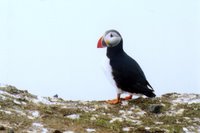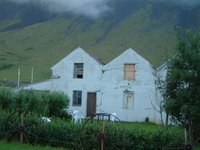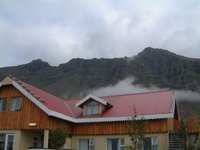The Brydebud General Store/Museum, which was once the site of the regional cooperative, is an interesting stop. The store was built on Heimaey in 1831, taken apart, then moved here to Vik and reassembled. Lots of old pictures and historical items are on display here.
Next we spend some time enjoying the black sand beaches of Vik, and admiring the two trolls who were in the process of stealing a three masted ship when they were caught, and frozen, by the rising sun. They are still there in the harbor looking like a rock formation, strangely enough, and called Reynisdrangar.
We were excited to see puffins at a distance on Heimaey; today at Vik we see them much closer, and find we can now identify their unique flight. Poor puffins...they have stubby bodies and
 short wings, so they aren't very aerodynamic. They have to flap their wings continuously and fast, 400 times per minute, and they are unable to glide. They work hard to fly! They swoop around the cliffs, float on the ocean, and dive down for fish, staying underwater for up to a minute. On the cliffs they can be seen with several small fish drooping from their bright orange beaks like little moustaches. They average 10 fish per trip, but have been known to carry 62 fish at once! Puffins live more than 20 years, and usually mate for life. Click here for the answers to 26 questions about puffins!
short wings, so they aren't very aerodynamic. They have to flap their wings continuously and fast, 400 times per minute, and they are unable to glide. They work hard to fly! They swoop around the cliffs, float on the ocean, and dive down for fish, staying underwater for up to a minute. On the cliffs they can be seen with several small fish drooping from their bright orange beaks like little moustaches. They average 10 fish per trip, but have been known to carry 62 fish at once! Puffins live more than 20 years, and usually mate for life. Click here for the answers to 26 questions about puffins!We tear ourselves away from birdwatching and sketching, and drive along the coast to the next big glacier where we take a scenic detour at Skaftafell National Park. Well, it would be scenic if it weren't raining so hard. It's foggy as well-- what will turn out to be one of the few "bad weather" days of our trip. We spend more time inside the park's information center than we do outside, because we get a drenching just coming in. Lunch is a picnic inside the car, with steamed up windows.
Now we drive along the edge of the giant glacier Vatnajokull, third largest in the world. It's hard to imagine how massive and huge it is; you can't see all of it at once, except from the air. The road changes from paved to gravel and back, and many bridges are one-laned, with small pull asides on the longer ones so that cars can pass. We go by the twisted steel remains of a huge bridge, mishappen from glacial flooding that followed a volcanic eruption. We reach Jokulsarlon late in the day, and John relates in his journal:
Jokulsarlon, the frigid lagoon with blocks of ice in shades of blue, floating silently. An occassional seal's head breaks the surface. We are encountering more people with less command of English--the waitress has to refer us to someone else so we can be understood. The large Icelander tells us there are no more boat tours [on the lagoon] today because they lost electricity. We should come back tomorrow. "Look to someone wearing a yellow lifewest and that be me!" Driving away from Jokulsarlon we drive through thousands of sea terns, swarming like gnats in the summer.We are staying at Gerdi tonight, to be close to the lagoon for tomorrow's visit. As we drive along
 the road we see HUGE BOOKS in the distance! Books as large as a one-story building, as tall as doors, an entire "shelf" of them lined up, the length of a house. All different colors and shapes, with titles on the spines! What on earth? The books are the turn-in to Gerdi, where we find our farmhouse accomodation. We check into an attractive building with lovely rooms. We have private rooms tonight, and we proceed to spread out our clean but wet laundry on the heat registers. We walk up hill, past the horse barns and farm equipment, to the BOOKS--which, it turns out, form the outer wall of a museum to a dead ancestor and writer who once lived at this farm. We hadn't heard of Thorbergur Thordarson, for of the dozens of books he wrote only one has been translated into English. At his museum we eat a small, overpriced dinner and are dumbfounded at the creative, elaborate displays that tell the story of this author's life. There are reconstructions of his house and study, old pictures, furniture and belongings...all of this, out in the middle of nowhere!
the road we see HUGE BOOKS in the distance! Books as large as a one-story building, as tall as doors, an entire "shelf" of them lined up, the length of a house. All different colors and shapes, with titles on the spines! What on earth? The books are the turn-in to Gerdi, where we find our farmhouse accomodation. We check into an attractive building with lovely rooms. We have private rooms tonight, and we proceed to spread out our clean but wet laundry on the heat registers. We walk up hill, past the horse barns and farm equipment, to the BOOKS--which, it turns out, form the outer wall of a museum to a dead ancestor and writer who once lived at this farm. We hadn't heard of Thorbergur Thordarson, for of the dozens of books he wrote only one has been translated into English. At his museum we eat a small, overpriced dinner and are dumbfounded at the creative, elaborate displays that tell the story of this author's life. There are reconstructions of his house and study, old pictures, furniture and belongings...all of this, out in the middle of nowhere!The most amazing item is a black and white photo of strong looking Icelandic men climbing the steep cliffs behind Gerdi to
 retrieve sheep that are stuck on the hillside, many hundreds of feet in the air. We discover that every face, ravine and crag of the huge mountain rising above us is named, so that the sheep farmers can communicate with each other as they climb different locations on the mountain to retrieve their sheep each year. These sheep wander higher and higher, as they summer in the grassy pastures, and can become stuck in inaccessible locations. Then, strong men with ropes go to fetch them. In order to believe this incredible story we pull out our binoculars and, sure enough, high up in the cliffs of the mountain sheep are scattered! During the rest of our trip we notice sheep in high mountain terrain, and we expect to see them tumbling down, but never do.
retrieve sheep that are stuck on the hillside, many hundreds of feet in the air. We discover that every face, ravine and crag of the huge mountain rising above us is named, so that the sheep farmers can communicate with each other as they climb different locations on the mountain to retrieve their sheep each year. These sheep wander higher and higher, as they summer in the grassy pastures, and can become stuck in inaccessible locations. Then, strong men with ropes go to fetch them. In order to believe this incredible story we pull out our binoculars and, sure enough, high up in the cliffs of the mountain sheep are scattered! During the rest of our trip we notice sheep in high mountain terrain, and we expect to see them tumbling down, but never do. Fog and clouds roll in and out, and we get just a few glimpses of the towering mountain behind Gerdi; mostly it's obscured, and only a few peaks are visible.
Fog and clouds roll in and out, and we get just a few glimpses of the towering mountain behind Gerdi; mostly it's obscured, and only a few peaks are visible.High 53°F Low 52°F
No comments:
Post a Comment